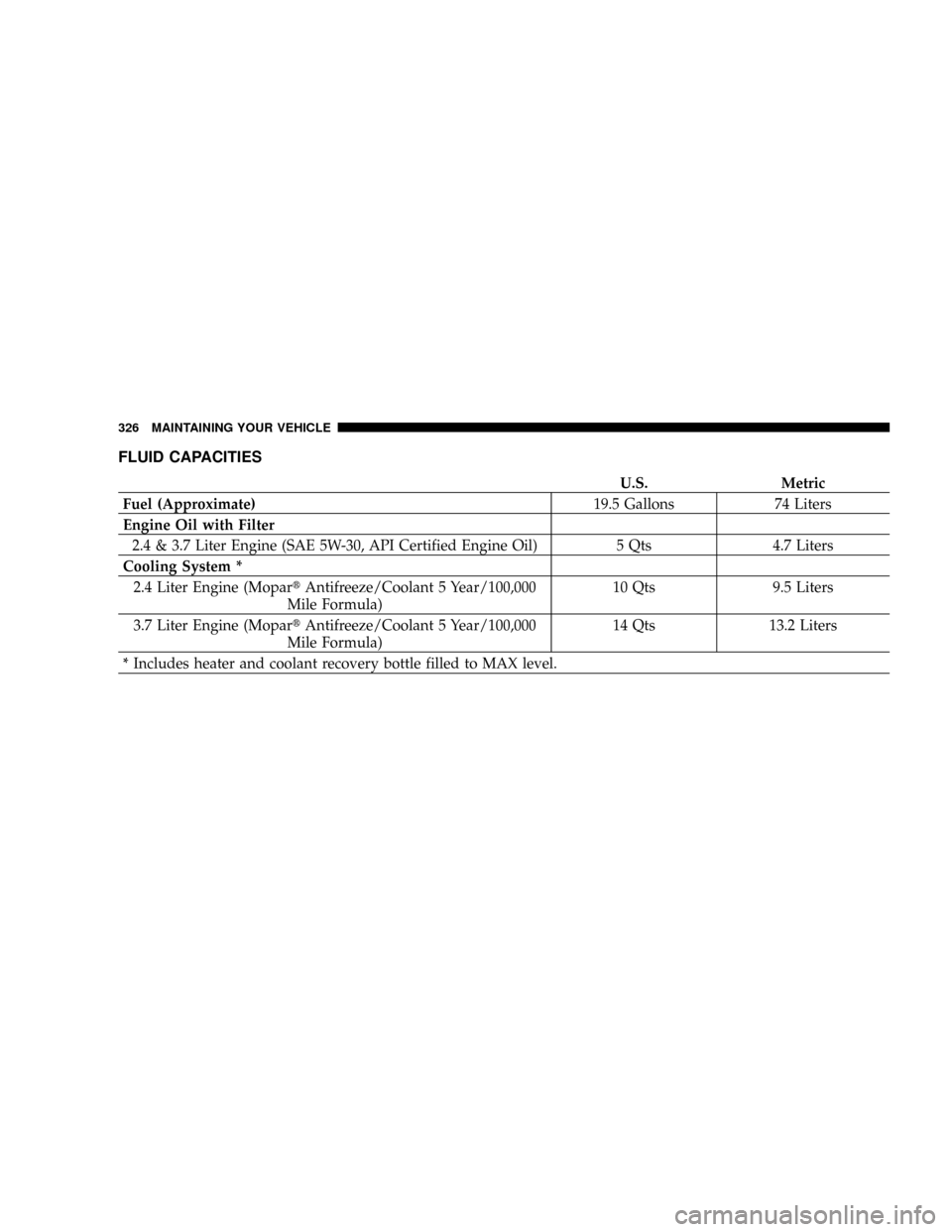cooling JEEP LIBERTY 2004 KJ / 1.G Owners Manual
[x] Cancel search | Manufacturer: JEEP, Model Year: 2004, Model line: LIBERTY, Model: JEEP LIBERTY 2004 KJ / 1.GPages: 374, PDF Size: 5.71 MB
Page 153 of 374

light will come on when the ignition switch is turned to
the ON position and may stay on for as long as three
seconds.
If the light comes back on immediately or comes on
during driving, it indicates that the Anti-Lock portion of
the brake system is not functioning and that service is
required, however, the conventional brake system will
continue to operate normally provided that the BRAKE
warning light is not on. Also, a chime will sound if the
light comes back on.
If the ABS light is on, the brake system should be serviced
as soon as possible to restore the benefit of Anti-Lock
Brakes.
The operation of the ABS light can be checked by turning
the ignition switch from the OFF position to the ON
position. The light should illuminate for approximately
two seconds. The light should then turn off unless theparking brake is applied or a brake fault is detected. If the
light does not illuminate, have the light inspected by an
authorized dealer.
10. Charging System Warning Light
This light shows the status of the electrical charg-
ing system. The light should come on for three
seconds when the ignition is first turned ON. If the light
comes back on immediately or comes on while driving, it
means that there is a problem with the charging system
or the battery is low. Also, a chime will sound if the light
comes back on. See your authorized dealer immediately.
11. Temperature Gage
Indicates engine coolant temperature. Any read-
ing within the normal range indicates that the
cooling system is operating satisfactorily.
The gage pointer will likely indicate a higher temperature
(above center scale) when driving in hot weather, up
mountain grades, in heavy stop and go traffic, or when
UNDERSTANDING YOUR INSTRUMENT PANEL 153
4
Page 273 of 374

IF YOUR ENGINE OVERHEATS
In any of the following situations, you can reduce the
potential for overheating by taking the appropriate ac-
tion.
²On the highways Ð Slow down.
²In city traffic Ð While stopped, put transmission in N
(Neutral), but do not increase engine idle speed.
NOTE:There are steps that you can take to slow down
an impending overheat condition. If your air conditioner
is on, turn it off. The air conditioning system adds heat to
the engine cooling system and turning off the A/C
removes this heat. You can also turn the Temperature
Control to maximum heat, the Mode Control to floor, and
the Fan Control to High. This allows the heater core to act
as a supplement to the radiator and aids in removing heat
from the engine cooling system.
CAUTION!
Driving with a hot cooling system could damage
your vehicle. If the temperature gauge reads ªHº,
pull over and stop the vehicle. Idle the vehicle with
the air conditioner turned off until the pointer drops
back into the normal range. If the pointer remains on
the ªHº, and you hear continuous chimes, turn the
engine off immediately, and call for service.
WHAT TO DO IN EMERGENCIES 273
6
Page 284 of 374

NPower Steering Fluid Check..............300
NDriveline And Steering Component
Lubrication..........................301
NBody Lubrication.....................301
NWindshield Wiper Blades................301
NWindshield Washers...................302
NExhaust System......................302
NCooling System.......................303
NHoses And Vacuum/Vapor Harnesses.......307
NBrake System........................308
NAutomatic Transmission................311
NHydraulic Clutch Fluid
Ð Manual Transmission................313
NManual Transmission..................313NTransfer Case........................313
NFront/Rear Axle Fluid..................315
NAppearance Care And Protection From
Corrosion...........................315
mFuse Panel...........................320
NInterior Fuses........................320
N
Underhood Fuses (Power Distribution Center). 323
mVehicle Storage........................324
mReplacement Bulbs......................324
mFluid Capacities........................326
mRecommended Fluids, Lubricants And Genuine
Parts................................327
NEngine.............................327
NChassis............................328
284 MAINTAINING YOUR VEHICLE
Page 303 of 374

or when the underside or rear of the vehicle is damaged;
have an authorized technician inspect the complete ex-
haust system and adjacent body areas for broken, dam-
aged, deteriorated, or mispositioned parts. Open seams
or loose connections could permit exhaust fumes to seep
into the passenger compartment. In addition, inspect the
exhaust system each time the vehicle is raised for lubri-
cation or oil change. Replace as required.
Cooling System
WARNING!
You or others can be badly burned by hot coolant or
steam from your radiator. If you see or hear steam
coming from under the hood, don't open the hood
until the radiator has had time to cool. Never try to
open a cooling system pressure cap when the radia-
tor or coolant bottle is hot.
Coolant Checks
Check coolant protection every 12 months (before the
onset of freezing weather, where applicable). If coolant is
dirty or rusty in appearance, the system should be
drained, flushed and refilled with fresh coolant.
Check the front of the radiator for any accumulation of
bugs, leaves, etc. Clean the radiator by gently spraying
water from a garden hose at the back of the core.
Check the engine cooling system hoses for condition and
tightness of connection. Inspect the entire system for
leaks. Any hoses that show cuts or severe abrasion must
be replaced.
Cooling System Ð Drain, Flush, And Refill
At the intervals shown in the appropriate ªMaintenance
Schedule,º the system should be drained, flushed, and
refilled.
MAINTAINING YOUR VEHICLE 303
7
Page 304 of 374

If the solution is dirty and contains a considerable
amount of sediment, clean and flush with reliable cooling
system cleaner. Follow with a thorough rinsing to remove
all deposits and chemicals.
Engine Coolant Disposal
Used ethylene glycol based engine coolant is a regulated
substance requiring proper disposal. Check with your
local authorities to determine the disposal rules for your
community. Do not store ethylene glycol based engine
coolant in open containers or allow it to remain in
puddles on the ground. Prevent ingestion by animals or
children. If ingested by a child, contact a physician
immediately.
Selection Of Coolant
Use only the manufacturer's recommended coolant, refer
to Recommended Fluids, Lubricants, and Genuine Parts
for correct coolant type.
CAUTION!
²Mixing of coolants other than the specified HOAT
coolant may result in decreased corrosion protec-
tion and engine damage that may not be covered
under the new vehicle warranty. If a non-HOAT
coolant is introduced into the cooling system in an
emergency, it should be replaced with the speci-
fied coolant as soon as possible.
²Do not use plain water alone or alcohol base
antifreeze products. Do not use additional rust
inhibitors or antirust products, as they may not be
compatible with the radiator coolant and may
plug the radiator.
²This vehicle has not been designed for use with
Propylene Glycol based coolants. Use of Propy-
lene Glycol base coolants is not recommended.
304 MAINTAINING YOUR VEHICLE
Page 305 of 374

Adding Coolant
When adding coolant, a minimum solution of 50% rec-
ommended ethylene glycol antifreeze coolant in water
should be used. Use higher concentrations (not to exceed
70%) if temperatures below -37ÉF (-38ÉC) are anticipated.
Use only high purity water such as distilled or deionized
water when mixing the water/antifreeze solution. The
use of lower quality water will reduce the amount of
corrosion protection in the engine cooling system.
Please note that it is the owner's responsibility to main-
tain the proper level of protection against freezing ac-
cording to the temperatures occurring in the area where
the vehicle is operated.
NOTE:Mixing coolant types will decrease the life of the
engine coolant and will require more frequent engine
coolant changes.
Cooling System Pressure Cap
The cap must be fully tightened to prevent loss of
coolant, and to insure that coolant will return to the
radiator from the coolant bottle.
The cap should be inspected and cleaned if there is any
accumulation of foreign material on the sealing surfaces.
WARNING!
The warning words DO NOT OPEN HOT on the
cooling system pressure cap are a safety precaution.
Never add coolant when the engine is overheated.
Do not loosen or remove the cap to cool an over-
heated engine. Heat causes pressure to build up in
the cooling system. To prevent scalding or injury, do
not remove the pressure cap while the system is hot
or under pressure.
MAINTAINING YOUR VEHICLE 305
7
Page 307 of 374

moisture from rain, snow, or high humidity accumulat-
ing on the radiator and being vaporized when the
thermostat opens, allowing hot water to enter the radia-
tor.
If an examination of your engine compartment shows no
evidence of radiator or hose leaks, the vehicle may be
safely driven. The vapor will soon dissipate.
²Do not overfill the coolant bottle.
²Check coolant freeze point in the system.
²If frequent coolant additions are required, or if the
level in the recovery bottle does not drop when the
engine cools, the cooling system should be pressure
tested for leaks.
²Maintain coolant concentration to 50% ethylene glycol
antifreeze (minimum) in water for proper corrosion
protection of your engine that contains aluminum
components.
²Make sure that the radiator and coolant bottle hoses
are not kinked or obstructed.
²Do not change the thermostat for summer or winter
operation. If replacement is ever necessary, install
ONLY the correct type thermostat. Other designs may
result in unsatisfactory cooling performance, poor gas
mileage, and increased emissions.
Hoses and Vacuum/Vapor Harnesses
Inspect surfaces of hoses and nylon tubing for evidence
of heat and mechanical damage. Hard or soft spots,
brittle rubber, cracking, tears, cuts, abrasions, and exces-
sive swelling indicate deterioration of the rubber.
Pay particular attention to the hoses nearest to high heat
sources such as the exhaust manifold. Inspect hose rout-
ing to be sure hoses do not touch any heat source or
moving component that may cause heat damage or
mechanical wear.
MAINTAINING YOUR VEHICLE 307
7
Page 326 of 374

FLUID CAPACITIES
U.S. Metric
Fuel (Approximate)19.5 Gallons 74 Liters
Engine Oil with Filter
2.4 & 3.7 Liter Engine (SAE 5W-30, API Certified Engine Oil) 5 Qts 4.7 Liters
Cooling System *
2.4 Liter Engine (MopartAntifreeze/Coolant 5 Year/100,000
Mile Formula)10 Qts 9.5 Liters
3.7 Liter Engine (MopartAntifreeze/Coolant 5 Year/100,000
Mile Formula)14 Qts 13.2 Liters
* Includes heater and coolant recovery bottle filled to MAX level.
326 MAINTAINING YOUR VEHICLE
Page 360 of 374

Catalytic Converter...................... 295
Caution, Exhaust Gas...................... 68
CD Changer......................164,171,182
CD Player...............167,169,174,180,183,186
CD Player Maintenance................... 197
Cellular Phone........................78,198
Chains, Tire............................ 257
Changing A Flat Tire..................... 274
Charging System Light.................... 153
Chart, Tire Sizing........................ 241
Child Restraint......................58,63,65
Child Restraint Tether Anchors.............62,63
Child Safety Locks........................ 22
Cigar Lighter........................... 135
Climate Control......................... 198
Clock................................ 158
Clutch Interlocking Ignition System........210,215
Command-Trac Operation.................. 222
Compact Disc Maintenance................. 197Compass.............................. 122
Compass Calibration..................... 122
Compass Variance....................... 123
Computer, Trip/Travel.................... 120
Console, Overhead....................... 110
Contract, Service........................ 350
Converter, Catalytic...................... 295
Cooling System......................... 303
Adding Coolant (Antifreeze).............. 305
Coolant Capacity...................... 326
Coolant Level......................... 306
Disposal of Used Coolant................ 304
Drain, Flush, and Refill.................. 303
Inspection........................... 303
Points to Remember.................... 306
Pressure Cap......................... 305
Radiator Cap......................... 305
Selection of Coolant..................304,326
Temperature Gauge..................... 153
360 INDEX
Page 362 of 374

Jump Starting......................... 279
Tow Hooks.......................... 281
Emission Control System Maintenance......288,330
Engine
Air Cleaner.......................... 297
Block Heater......................... 212
Break-In Recommendations................ 68
Checking Oil Level..................... 290
Compartment......................285,286
Compartment Identification............285,286
Cooling............................. 303
Fails to Start.......................... 211
Flooded, Starting...................... 211
Fuel Requirements..................259,326
Jump Starting......................... 279
Malfunction Indicator................... 152
Oil ..............................290,326
Oil Change Interval.................... 292
Oil Disposal.......................... 294Oil Filter............................ 294
Oil Filter Disposal...................... 294
Oil Selection.......................293,326
Overheating.......................... 273
Starting............................. 210
Temperature Gauge..................... 153
Timing Belt.......................... 297
Engine Oil Viscosity Chart................. 293
Enhanced Accident Response Feature.......... 56
Entry System, Illuminated.................. 17
Exhaust Gas Caution...................... 68
Exhaust System......................... 302
Exterior Finish Care...................... 316
Filters
Air Cleaner.......................... 297
Engine Oil........................... 294
Finish Care............................ 316
362 INDEX